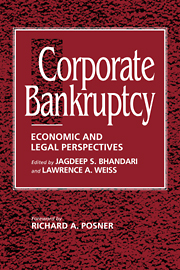Book contents
- Frontmatter
- Contents
- List of tables and figures
- Foreword by the HONORABLE RICHARD A. POSNER
- Preface
- Part I The role of credit
- Part II Bankruptcy as a reflection of the creditors' implicit bargain
- Part III Beyond the basic creditors' bargain
- Part IV Workouts or bargaining in the shadow of bankruptcy
- Part V Alternatives to bankruptcy and the creditors' bargain
- 21 Corporate control and the politics of finance
- 22 The uneasy case for corporate reorganizations
- 23 Bankruptcy and debt: A new model for corporate reorganization
- 24 A new approach to corporate reorganizations
- 25 Debtor's choice: A menu approach to corporate bankruptcy
- 26 Is corporate bankruptcy efficient?
- 27 The voting prohibition in bond workouts
- 28 Financial and political theories of American corporate bankruptcy
- Part VI Experience of other countries
- Index
28 - Financial and political theories of American corporate bankruptcy
Published online by Cambridge University Press: 10 December 2009
- Frontmatter
- Contents
- List of tables and figures
- Foreword by the HONORABLE RICHARD A. POSNER
- Preface
- Part I The role of credit
- Part II Bankruptcy as a reflection of the creditors' implicit bargain
- Part III Beyond the basic creditors' bargain
- Part IV Workouts or bargaining in the shadow of bankruptcy
- Part V Alternatives to bankruptcy and the creditors' bargain
- 21 Corporate control and the politics of finance
- 22 The uneasy case for corporate reorganizations
- 23 Bankruptcy and debt: A new model for corporate reorganization
- 24 A new approach to corporate reorganizations
- 25 Debtor's choice: A menu approach to corporate bankruptcy
- 26 Is corporate bankruptcy efficient?
- 27 The voting prohibition in bond workouts
- 28 Financial and political theories of American corporate bankruptcy
- Part VI Experience of other countries
- Index
Summary
Introduction
What explains American corporate bankruptcy, with its time-consuming and expensive reorganization process? Accepted wisdom is that bankruptcy protects an insolvent debtor's assets from its creditors who would otherwise dismantle the debtor in a frenzied attempt to collect on their loans. By providing for an orderly disposition of claims against a debtor firm, bankruptcy law preserves intact the firm's “common pool” of assets available to creditors. In this classic account, creditors willingly bear the costs of bankruptcy because the alternative is worse: a contentious race among creditors and destruction of the firm. Thus, the bankruptcy system is seen as a lesser of evils.
I argue here that the willingness of creditors and other investors to accept the corporate bankruptcy process is as much a political adaptation as an economic decision. The common pool justification for corporate bankruptcy is unsatisfactory. It assumes that without bankruptcy law creditors would destroy insolvent, but viable firms. This assumption is ill-founded. In a legal environment hospitable to all forms of contract, investors could agree efficiently to preserve a firm's value without the aid of the costly, rule-based bankruptcy process. We do not observe such agreements in the United States because political compromises have produced a legal regime that discourages optimal contracts.
The Common Pool Illusion
A solution to the supposed common pool problem lies at the heart of existing bankruptcy law. Bankruptcy's proponents argue that creditors of an insolvent firm, left to their own devices, would expend resources first preparing for, then entering, a race to collect limited assets.
- Type
- Chapter
- Information
- Corporate BankruptcyEconomic and Legal Perspectives, pp. 434 - 448Publisher: Cambridge University PressPrint publication year: 1996



